A good swing sees the arms and the body work together to create a fluent, repeating motion. Only when the arms and body are properly ‘connected’ throughout the swing do you benefit from the rhythm and timing so vital to good ball-striking. The following drills will help you to piece together a good swing, and thus improve your striking and up your distance.
The set-up: identifying common faults
Unless your posture creates a good relationship between your body and your arms, hands and the club, there is little chance that good connection will feature in the swing itself. Here are two faults to watch out for.
First up, a common set-up fault: notice that the left shoulder is set a little too low, the hands are placed behind the ball and the elbows are ‘ clearly separated. I would describe this type of posture as generally ‘stooped’, and clearly there is little likelihood of a player making a coordinated swing from here.
Another faulty position that I see all too often at clubs up and down the country: the weight is settled too much on the right side, the head is tilted to the right, away from the target, and the hands are poorly positioned behind the centre of the body. Look at how weakly the hips are angled away from the target.
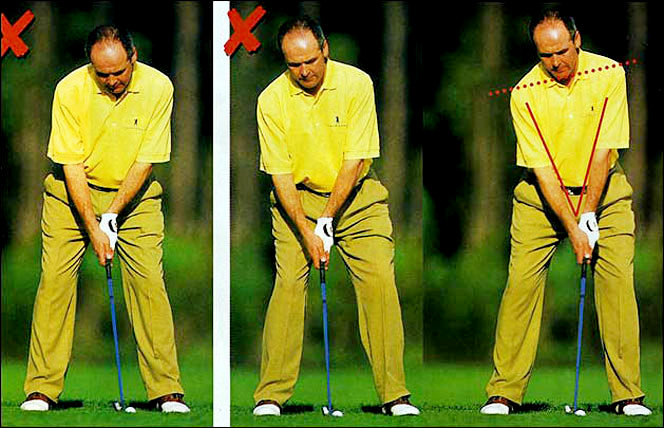
Setting up a good connection
This is more like it. The hands are now correctly positioned just ahead of the ball, the left shoulder slightly above the right, creating a good slant. The body weight is now evenly distributed between the feet, as it should be with a mid-iron, and there is a distinct ‘V formed by the forearms.
Crimewatch: back swing. faults that could keep you awake at night…
Once you understand the basics of a good set-up position, working on your swing to achieve a solid back swing. is the key to your consistency. Here are a couple of positions to be avoided at all costs, while below is a simple drill that will help you to get used to the feeling of swinging the club into the desired ‘slot’ at the top of your back swing., ready to unwind into the back of the ball.
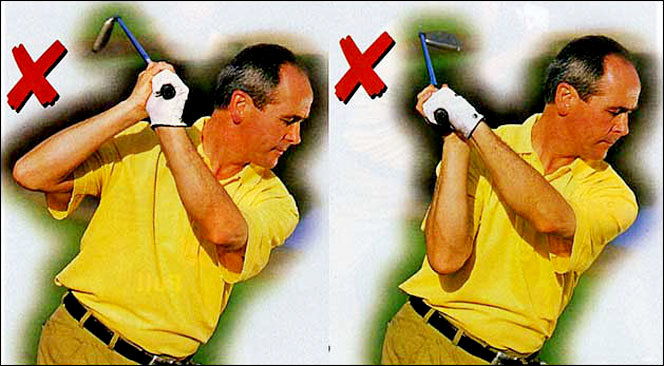
Here the back swing. movement has been dominated by the arms, which have worked independently of the body, ‘lifting’ the club into this weak position. The right elbow is too high, the left arm has clearly collapsed, and the club face is excessively open (i.e. the toe of the club is pointing straight to the ground.
Virtually the opposite: this time, the arms can be seen to have remained much too close to the body, resulting in a cramped position, with the folded right elbow being too low at the top. The arms are too close together, while the club shaft almost sits on the right shoulder, and the club face is closed (i.e. the face is pointing straight up towards the sky). No hope of consistency from here.
How to get your swing on track
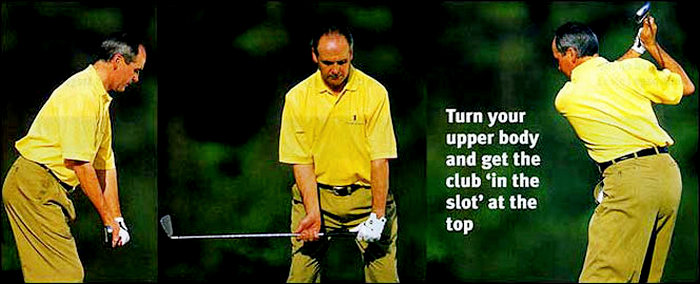
Follow this drill to set-up the perfect top of the back swing. position.
Start this drill by adopting a good, athletic posture, then split your hands on the grip and set the shaft parallel to the ground and pointing in the direction of the target (as seen from two angles above). Note how the back swing. looks ‘primed‘ from this position.
Now, to put your swing in motion, simply turn your upper body to achieve this solid and powerful position at the top – hold it and feel it. Repeat this drill as often as necessary to develop good muscle memory as you train your body to swing the club into the slot.
Create, store, and release the energy in your swing
How do you wind and unwind your body to maximise the energy in your swing? This drill will help you feel the way in which a dynamic swing first ‘loads’ up energy, how that energy is then stored in the transition, and finally ‘released’ on the ball through impact.
To get ready for this exercise you first need to split your hands on the club and set-up to the ball with the club shaft parallel to the ground and to the direction of your target- just as I demonstrated on the previous page pic 1).
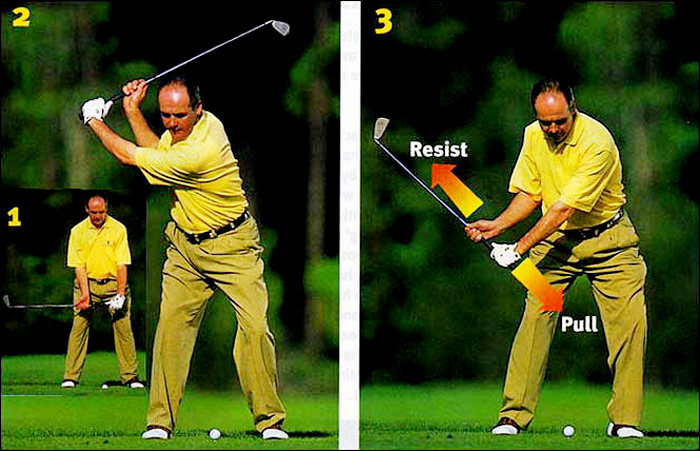
From the set-up position, turn your upper body to swing the club back to this three-quarter position (pic 2). Try to maintain the flex in your knees to stabilise the turning of the upper body. Pause at the top as you get ready to unwind the downswing.
As you start back down, sense that you pull the club down with the left hand while resisting with the right . As the club approaches waist-high, prepare to let go with your right hand. The left hand should be firmly in control at this stage.
Total break down…
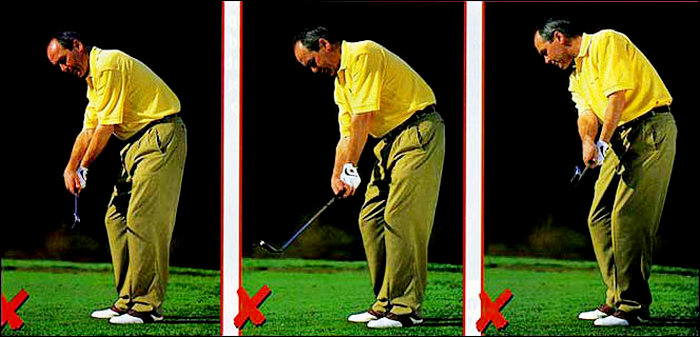
At first glance you may think that only the position to the left is incorrect, the hands clearly working independently of the arms and body. But in fact all three of these post-impact positions illustrate a poor release.
This example, typical of players who tend to lose their shots high and to the right, is not so severe, but faulty none the less. Look at the way the right hand has released ‘under’ the left, leaving the club face open. A rather ‘scoopy’type of action.
In this case, the right hand has prematurely rolled over the left, closing the club face on the ball to produce a hook or a pulled shot left of target. The better player’s fault. Note, also, that the hips have been slow to clear, or unwind, left of the target.
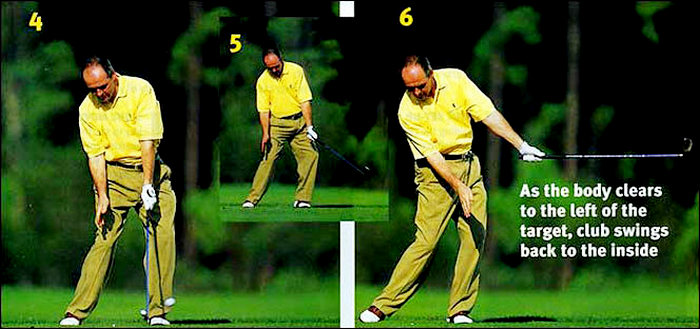
Through impact the left wrist holds the club face square as the body unwinds and rotates to the left of the target pic 4). There is no sign of any collapse . At the same time, the hips are turning to clear the path for the arms to swing through (pics 5 & 6). Note that the butt-end of the grip remains facing my belt buckle.
The beauty of this exercise is that it gives you instant feedback as to the quality of the ‘connection’ between your arm-swing and your body action.
Club, body release ‘together’
The body has rotated left and cleared correctly, the arms are connected to the body action and the club face is square to the upper body. This is the position you expect to see in a dynamic swing – just as Nick Faldo demonstrates here.
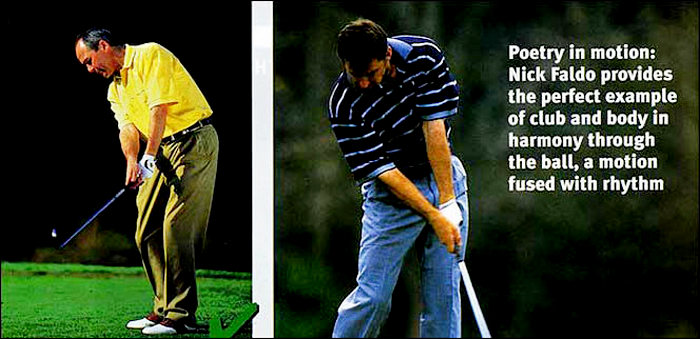
Making (and maintaining) good arm-body ‘connection’
Finally, here’s a drill that will help you to appreciate and understand the importance of maintaining a ‘connection’ between your left arm and the rotation and the release of your body during the downswing. Better players can attempt to hit shots as they rehearse this drill with a short iron. Higher handicap players are better advised to aim at simply clipping a tee-peg out of the ground, or swinging in rough grass, which provides good resistance at impact.
Use this drill to develop your swing, and also as a warm-up exercise before you go out to play. The more you rehearse this and the other exercises in this article, the better the connection between your arm-swing and your body action wilt be, with tangible results in the quality of your ball-striking.
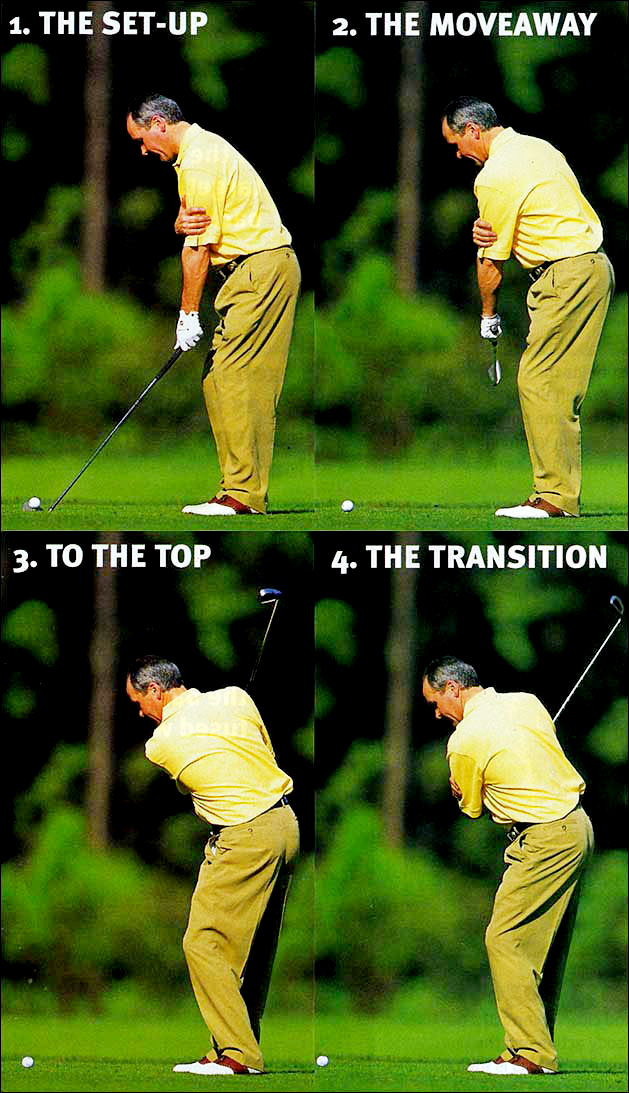
1 The Set-Up
Holding the club with your left hand on the grip, set-up to the ball (or address a tee-peg) with your right arm positioned across your chest, your right hand clasping the upper part of your left arm.
The key to this drill is to feel that you pull the upper part of the left arm towards your chest, and to maintain that pressure as you swing the club.
2. The Moveaway
The key to starting this exercise correctly is to feel that your right arm pulls the left across your chest, moving the club head naturally away from the ball on the inside path. Try to get a sense that your arms and upper body are (at all times during the swing) working nicely ‘together’.
3. To the Top
The rotary motion of your upper body-and the continued connection between your left arm and torso – should combine to give you a compact three-quarter back swing. position.
4. The Transition
To maximise the benefit of this drill, you want to feel that your right hand keeps the pressure on the upper part of your left arm as you change direction. That will help you to drop your swing on to the correct downswing plane, and serves to reinforce the connection in your swing during this critical period.
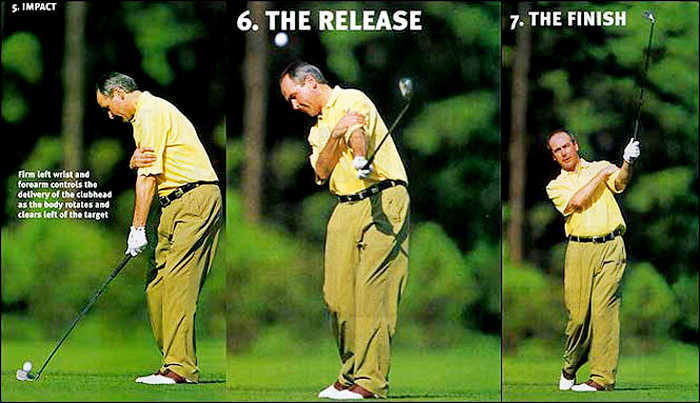
5. The Impact
Compare this impact position to the original set-up position and you will see that the body has cleared (and is in the process of rotating and clearing), while the left arm controls the delivery of the club head squarely to the back of the ball. The left wrist is firm.
6. The Release
As the body continues to rotate to the left of the target, the connection between the left arm and the body is maintained long after the ball has gone. The left arm has now straightened and the club is swinging inside once again a mirror image of the back swing.
7. The Finish
Having turned all the way through the shot to face the target, the body is relaxed and in balance, while the left arm remains connected to the chest. If I were to put my right hand on the club, I would have a good three-quarter finish.
